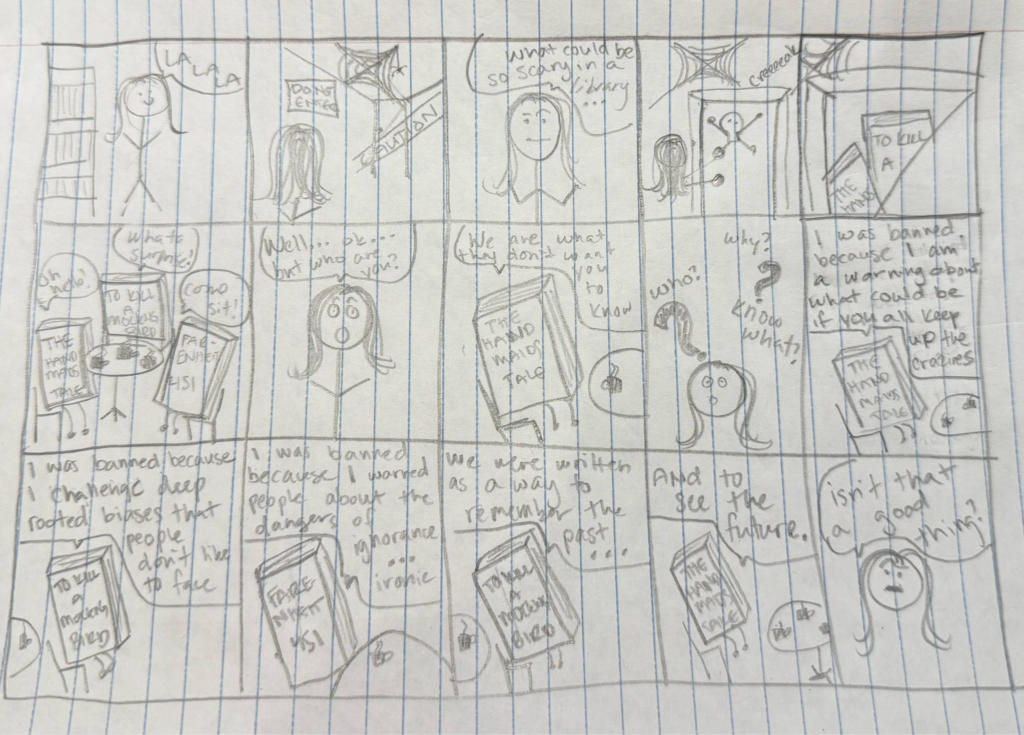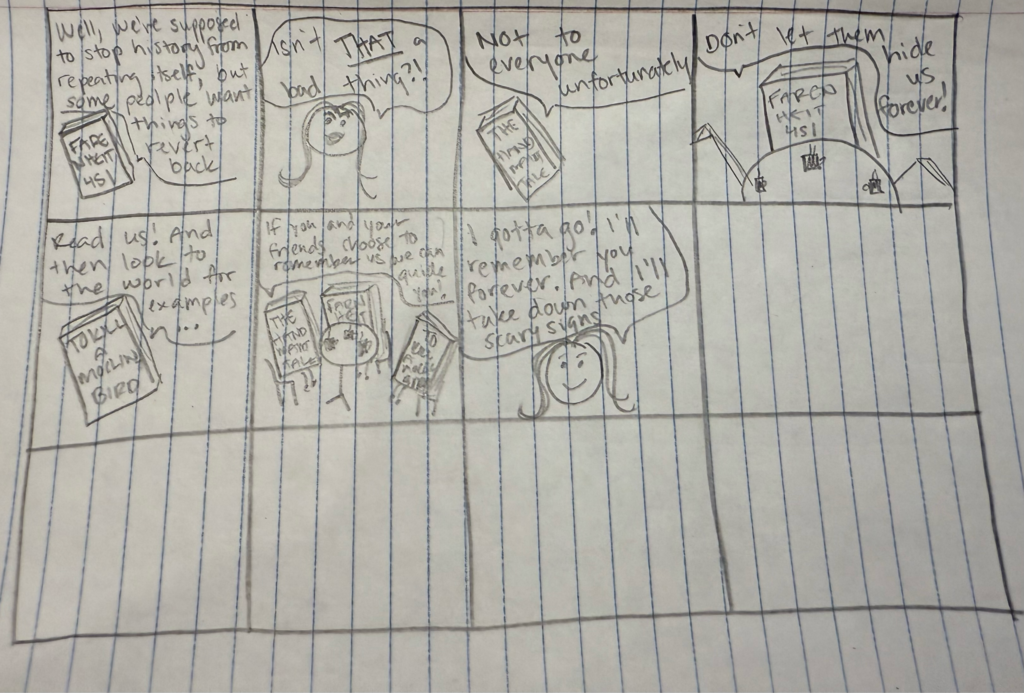The Banned Books (Comic)
Banned books and their stories.
Updated: Sept 17, 2025
Authors: Emily Morrow
This project is an individual assignment focusing on the implementation of design tools and multimedia principles in formatting an effective and educational comic. My goals with this project are to create a comic that is engaging and to gain a deeper understanding of multimedia learning.
FINAL DESIGN COMING SOON
THE PROCESS
Understand (Discover, Interpret, Specify)
DESCRIBE THE CHALLENGE:
It is imperative that as more books become banned from schools, we continue to engage with the literature and look at the social and political implications of this.
CONTEXT AND AUDIENCE:
This comic is created mainly for secondary school students. The reason I have selected this demographic is because book banning has become increasingly relevant in high schools across the US and now Canada. As we see provinces beginning to ban certain books, we must start making youth aware of this and why it is happening. I chose to not make the comic for elementary or middle school aged children as I feel the content is slightly more mature despite the light hearted nature of the graphics.
While this is an important demographic to educate, teenagers are notoriously hard to impress or intrigue. Especially with the growth of social media and decline of literature consumption, this group may beg the question “why do I care?”. To intrigue the target demographic, something easily consumable, exciting to look at, and slightly light hearted seems like it will be the most effective way to engage them in material they might not engage with otherwise. I believe the ease of consuming a 12-20 panel comic strip versus a 12-20 page academic paper is a universal agreement, especially in the age of social media and quick dopamine.
Post secondary students and adults may also benefit from this style of learning. While some may be acutely aware of the dangers and frequency of book banning, not all understand that it is happening or what it is.
The goal of this comic is to expose some of the pieces of literature that have been banned, why they have been banned, and encourage the reader to critically assess if they agree with this decision or not. With constant debate and tensions about limits on free speech, it is important to challenge learners to think about the consequences of removal and censorship.
POV STATEMENT:
Students need to be aware of the books that have been banned so that they can educate themselves on the content and assess the implications of the ban.
LEARNING OBJECTIVES:
Readers will understand the concept of banned books and be able to assess the implications of which books have been banned and the power used to ban them. This hopefully will inspire the reader(s) to share with others about this topic.
Plan (Ideate, Sketch, Elaborate)
IDEATION:
- My brainstorming process started by looking at ideas that would be taught in a secondary school English classroom such as punctuation placement and sentence structure but these didn’t really intrigue me. I thought about being in an English class and the discussions that arise about themes in novels: morality, loyalty, heartbreak, political turmoil, etc. Turning those concepts into a comic intrigued me and could help students create mental models of themes. I couldn’t think of a way to turn a novel’s theme into a comic without having to over complicate this assignment with the context of the novel. I remembered a news post I saw a few weeks ago about books being banned in Alberta classrooms. I always found this such an intriguing topic and remembered that in high school I was completely unaware that this was something that could even happen. I liked the idea of painting the books as these scary monsters from afar but when you get up close you realize they are harmless and just trying to help. I figured the best way to do this was to have them be depicted to an outsider as monsters locked in a back room. When a student stumbles upon them, full of fear, we realize they are harmless. I like the concept of letting the books speak for themselves as well.
- The best ideas I have come up with have included fun graphics and colourful designs. As well as dialogue between the main character and the books.
STORYBOARD OR SCRIPT:
| Kid walking through library – happy | Shot of a sign “WARNING: go no further” | Kid confused – goes further “what could be so scary in a library?” | More signs and caution tape – kid starts shaking – bead of sweat on forehead |
| A creepy looking door – hears sounds from behind it | Nervously goes up and grabs handle | Door slowly creaks open | Kid peaks in |
| Larger than normal books sitting quietly (Farenheit 451, To Kill a Mockingbird, The handmaids tale) turn to ‘look’ at kid | They are excited to see the kid and invited it to join at table for conversation | Kid asks “who are you?” | Books: “we are what they don’t want you to know” |
| Kid confused “who doesn’t want me to know? Know what” | Book 1 says its title and why it is banned | Book 2 says its title and why its is banned | Book 3 says its title and why it is banned |
| Book 1 ‘ we were written as a way to remember the past and see the future’ | Kid “isn’t that a good thing?” | Book 2 ‘some people don’t think so’ | Kid “ why would they hide you? Why is it bad?” |
| Book 3 “the people who made us scare the people who banned us” | Book 2 “we’re supposed to help stop the past from repeating itself” | Book 1 “But some people want that. So they don’t want you to read about what happens when they slowly start repeating it” | Kid “That sounds scary! Some things that are in your stories are really hurtful to people. How can we stop those people from doing it again if you guys are hidden” |
| Book 1 “Don’t let them hide us! There are more like us too. Read us all and share with people you know” | Book 2 “Ask questions to the people around you. Look out for people who remind you of the villains in these books” | Book 3 “If you and your friends choose to remember us, then we will be able to help guide you” | Kid “I gotta go! Thank you guys, I’ll keep you in my mind forever! And I’ll take down those scary signs that lead to you” |
PRINCIPLES APPLIED:
- Limited Capacity Principle: Choosing books that are likely to be familiar to the reader helps lift any extraneous load. Making the dialogue fairly simple aims for a low intrinsic load for most people in the target demographic.
- Signalling principle: Having the danger signs and a creepy feel to the room the books are in highlights the importance of them to the story and also creates the emotion you are supposed to feel toward them.
- Contiguity principle: The speech bubbles or narrations will be held within the same box as the picture they are referring to to ensure the most ease in interpretation.
- Personalization principle/voice principle: Having the books be animated and talking helps to create a unique experience and make the content more approachable than if it were to just be written out.
- Modality: Having the words alongside the pictures will be more impactful than the words on their own.
Important Note: Complete drafts of Phases 1 and 2 before starting your prototype.
Create and Share the Prototype


Notes: In the final copy the panels will be larger so the text will feel less crowded. The books will also have their original colours to make them more recognizable and distinguishable.